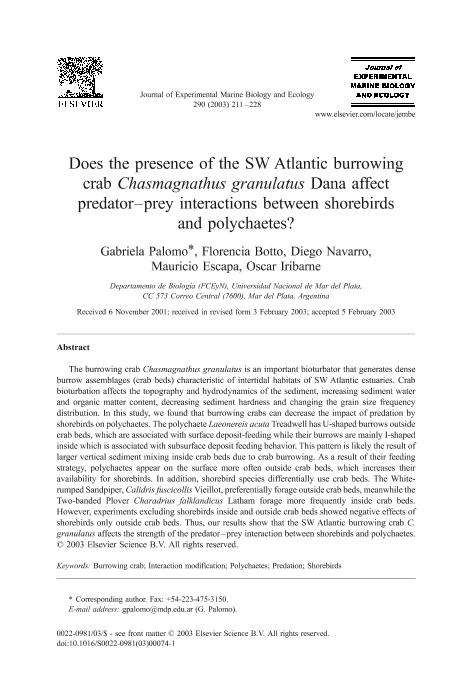Artículo
Does the presence of the SW Atlantic burrowing crab Chasmagnathus granulatus Dana affect predator–prey interactions between shorebirds and polychaetes?
Palomo, Maria Gabriela ; Botto, Florencia
; Botto, Florencia ; Navarro, Diego
; Navarro, Diego ; Escapa, Carlos Mauricio
; Escapa, Carlos Mauricio ; Iribarne, Oscar Osvaldo
; Iribarne, Oscar Osvaldo
 ; Botto, Florencia
; Botto, Florencia ; Navarro, Diego
; Navarro, Diego ; Escapa, Carlos Mauricio
; Escapa, Carlos Mauricio ; Iribarne, Oscar Osvaldo
; Iribarne, Oscar Osvaldo
Fecha de publicación:
07/2003
Editorial:
Elsevier Science
Revista:
Journal of Experimental Marine Biology and Ecology
ISSN:
0022-0981
Idioma:
Inglés
Tipo de recurso:
Artículo publicado
Clasificación temática:
Resumen
The burrowing crab Chasmagnathus granulatus is an important bioturbator that generates dense burrow assemblages (crab beds) characteristic of intertidal habitats of SW Atlantic estuaries. Crab bioturbation affects the topography and hydrodynamics of the sediment, increasing sediment water and organic matter content, decreasing sediment hardness and changing the grain size frequency distribution. In this study, we found that burrowing crabs can decrease the impact of predation by shorebirds on polychaetes. The polychaete Laeonereis acuta Treadwell has U-shaped burrows outside crab beds, which are associated with surface deposit-feeding while their burrows are mainly I-shaped inside which is associated with subsurface deposit feeding behavior. This pattern is likely the result of larger vertical sediment mixing inside crab beds due to crab burrowing. As a result of their feeding strategy, polychaetes appear on the surface more often outside crab beds, which increases their availability for shorebirds. In addition, shorebird species differentially use crab beds. The White- rumped Sandpiper, Calidris fuscicollis Vieillot, preferentially forage outside crab beds, meanwhile the Two-banded Plover Charadrius falklandicus Latham forage more frequently inside crab beds. However, experiments excluding shorebirds inside and outside crab beds showed negative effects of shorebirds only outside crab beds. Thus, our results show that the SW Atlantic burrowing crab C. granulatus affects the strength of the predator–prey interaction between shorebirds and polychaetes.
Palabras clave:
Burrowing Crab
,
Predation
,
Polychaetes
,
Shorebirds
Archivos asociados
Licencia
Identificadores
Colecciones
Articulos(IADO)
Articulos de INST.ARG.DE OCEANOGRAFIA (I)
Articulos de INST.ARG.DE OCEANOGRAFIA (I)
Citación
Palomo, Maria Gabriela; Botto, Florencia; Navarro, Diego; Escapa, Carlos Mauricio; Iribarne, Oscar Osvaldo; Does the presence of the SW Atlantic burrowing crab Chasmagnathus granulatus Dana affect predator–prey interactions between shorebirds and polychaetes?; Elsevier Science; Journal of Experimental Marine Biology and Ecology; 290; 7-2003; 211-228
Compartir
Altmétricas



